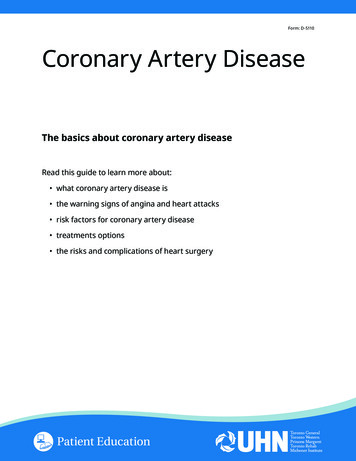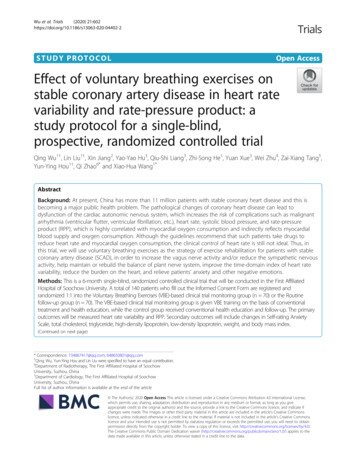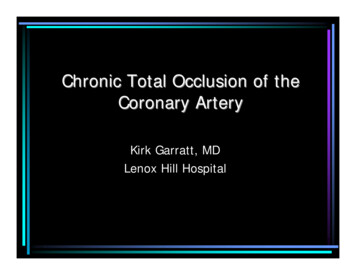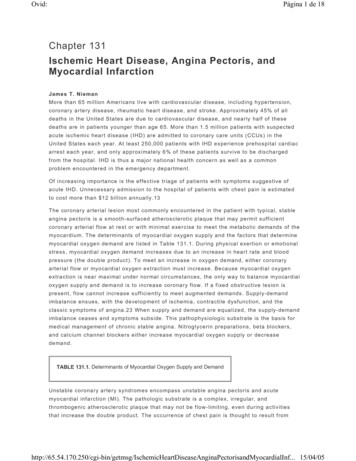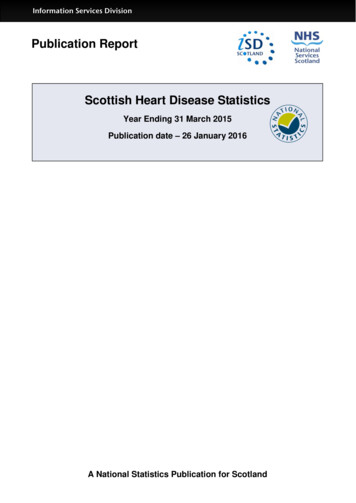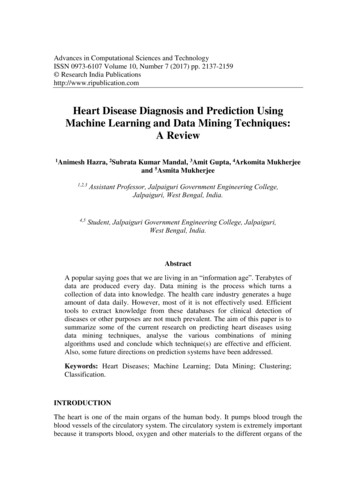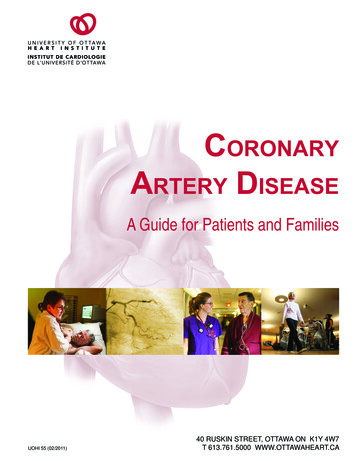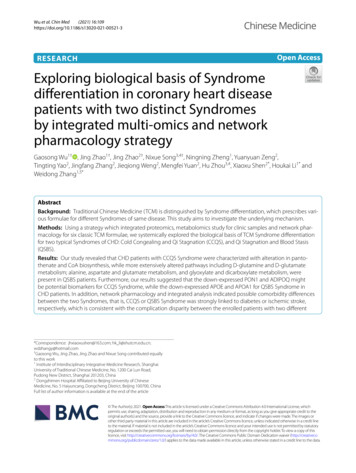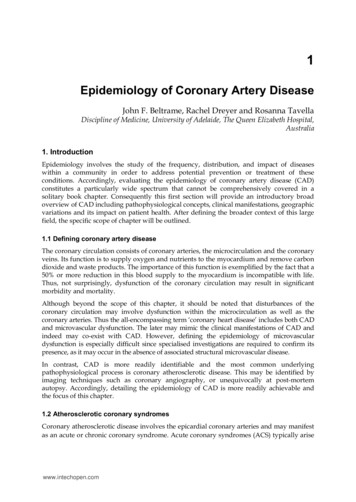
Transcription
1Epidemiology of Coronary Artery DiseaseJohn F. Beltrame, Rachel Dreyer and Rosanna TavellaDiscipline of Medicine, University of Adelaide, The Queen Elizabeth Hospital,Australia1. IntroductionEpidemiology involves the study of the frequency, distribution, and impact of diseaseswithin a community in order to address potential prevention or treatment of theseconditions. Accordingly, evaluating the epidemiology of coronary artery disease (CAD)constitutes a particularly wide spectrum that cannot be comprehensively covered in asolitary book chapter. Consequently this first section will provide an introductory broadoverview of CAD including pathophysiological concepts, clinical manifestations, geographicvariations and its impact on patient health. After defining the broader context of this largefield, the specific scope of chapter will be outlined.1.1 Defining coronary artery diseaseThe coronary circulation consists of coronary arteries, the microcirculation and the coronaryveins. Its function is to supply oxygen and nutrients to the myocardium and remove carbondioxide and waste products. The importance of this function is exemplified by the fact that a50% or more reduction in this blood supply to the myocardium is incompatible with life.Thus, not surprisingly, dysfunction of the coronary circulation may result in significantmorbidity and mortality.Although beyond the scope of this chapter, it should be noted that disturbances of thecoronary circulation may involve dysfunction within the microcirculation as well as thecoronary arteries. Thus the all-encompassing term ‘coronary heart disease’ includes both CADand microvascular dysfunction. The later may mimic the clinical manifestations of CAD andindeed may co-exist with CAD. However, defining the epidemiology of microvasculardysfunction is especially difficult since specialised investigations are required to confirm itspresence, as it may occur in the absence of associated structural microvascular disease.In contrast, CAD is more readily identifiable and the most common underlyingpathophysiological process is coronary atherosclerotic disease. This may be identified byimaging techniques such as coronary angiography, or unequivocally at post-mortemautopsy. Accordingly, detailing the epidemiology of CAD is more readily achievable andthe focus of this chapter.1.2 Atherosclerotic coronary syndromesCoronary atherosclerotic disease involves the epicardial coronary arteries and may manifestas an acute or chronic coronary syndrome. Acute coronary syndromes (ACS) typically arisewww.intechopen.com
4Coronary Artery Disease– Current Concepts in Epidemiology, Pathophysiology, Diagnostics and Treatmentfrom atherosclerotic plaque rupture with subsequent coronary thrombosis and/or spasm.The resulting coronary artery occlusion gives rise to intense myocardial ischaemia or evenmyocardial necrosis thereby manifesting as unstable angina or myocardial infarction. Onoccasions, the ischaemia/infarction may manifest as sudden cardiac death from malignantarrhythmias or acute pulmonary oedema in the compromised left ventricle. Hence ACS mayhave a spectrum of clinical manifestations ranging from unstable angina, acute myocardialinfarction, acute pulmonary oedema or even sudden death, all arising from the sameunderlying pathophysiological process.Chronic coronary syndromes (CCS) may also arise from coronary atherosclerotic disease.This typically manifests as exertional angina arising from a coronary atherosclerotic lesionthat has progressed to the extent that it compromises coronary blood flow to themyocardium during the increased oxygen demand associated with exercise. As thisobstructive lesion is non-occlusive, adequate oxygen supply is restored once the excessmyocardial oxygen demand is removed with the cessation of exercise and thus theresolution of the ischaemic chest pain. Hence the principal manifestation of CCS is anginapectoris, which can be monitored in epidemiologic studies.1.3 Geographic variations in coronary artery diseaseThe global prevalence of these CAD-related clinical manifestations is increasing althoughthere are regional variations that are influenced by the extent of economic developmentand social organisation. With industrialisation, there is a shift from nutritional andinfectious disorders to the chronic diseases such as CAD. This ‘epidemiologic transition’has been described as involving 4 stages (Omran, 1971), as detailed in Table 1, (Yusuf etal, 2001). In developing countries, infectious disease and nutritional deficiency areresponsible for most deaths (Stage 1) and cardiovascular disease plays only a minor role.The cardiovascular disorders (CVD) that are prevalent in these communities includeinfectious disease such as rheumatic heart disease or nutritional disorders such asberiberi. With improvements in public health and nutrition, these conditions become lessprevalent and disorders related to uncontrolled hypertension become more common(Stage 2). With further industrialisation, lifestyle diseases become more evident. Thussmoking, high fat diets and obesity result in the rapid development of atherosclerosis sothat CAD mortality is a major cause of death in middle-aged individuals (Stage 3). Withfurther improvements in public health measures to address these lifestyle risk factors andadvances in medical care, atherosclerotic disease associated mortality is delayed so that itis a condition of the elderly (Stage 4). Progression through each of these transition stagesis associated with a greater life expectancy. Moreover as shown in Table 1, cardiovasculardisease (and especially CAD) contributes proportionally more to the total populationmortality.As evident from Table 1, CAD is present across the globe although its frequency varies withgeographic region. Consequently there is a wide spectrum in the prevalence of CAD indeveloping and industrialised countries; thus discussions relevant to one country may notbe necessarily be pertinent to others. Hence it is important to report on the context of thefindings when describing the epidemiology of CAD.www.intechopen.com
Epidemiology of Coronary Artery DiseaseTransition Stage1. Infections &NutritionalDeficiency2. HypertensiveDiseases3. AtheroscleroticCVD in theMiddle-aged4. AtheroscleroticCVD in theElderly%Deaths*5-10%10-35%35-65% 50%5Cardiovascular ConditionsCountries Rheumatic Heart Disease Sub-Saharan Africa Nutritional Cardiomyopathy Rural South America Rural Southern Asia Haemorrhagic Stroke China Hypertensive Heart Disease Urban Southern Asia CAD Urban India Atherothrombotic Stroke Latin America Former USSR CAD Western Europe Atherothrombotic Stroke North America Heart Failure Australia, NewZealand# Adapted from Yusuf et al, Circulation 2001, 104:2746-53. (Yusuf et al, 2001)*%Deaths from CVD, in relation to total deaths. CVD Cardiovascular Disease.Table 1. The Epidemiologic Transition of Cardiovascular Disease#.1.4 Health status in coronary artery diseaseEpidemiology not only involves monitoring diseases within the community but also theirimpact on health. Thus the focus should not only be on the disease manifestations of CAD(such as acute and chronic coronary syndromes) but also the patient’s perception of theimpact of these disorders on their health. The term ‘health status’ (see Figure 1) is used todefine the patient’s perception (rather than the clinician’s perception) of the disease processon their lifestyle. This incorporates the symptoms experienced (e.g. angina), the functionallimitation from the symptom (eg reduced exercise tolerance) and quality of life (i.e. theRumsfeld, Circulation 2002, 106:5-7. (Rumsfeld, 2002). Copyright gained from Wolters Kluwer Health04/08/2011Fig. 1. Summary of Patient-centred Health Status.www.intechopen.com
6Coronary Artery Disease– Current Concepts in Epidemiology, Pathophysiology, Diagnostics and Treatmentdiscrepancy between actual and desired function) (Rumsfeld, 2002). Thus congruous withour evolving patient-centred health care, this chapter will not only focus on CAD in relationto the prevalence and incidence of disease processes but will also detail the impact of CADon health status.1.5 Scope of the chapterConsidering the wide spectrum encompassing CAD epidemiology, it is necessary to limitthe topics covered in this chapter. Thus the chapter will evaluate overall CAD mortality,myocardial infarction as an example of an ACS and chronic stable angina as the example ofa CCS. Within each of these areas, the discussion will focus on (1) the difficulty andlimitations in defining the condition and thus its impact in interpreting the data, (2) theprevalence of the condition, (3) the incidence of the condition, where relevant, (4) and theimpact of the condition on health status, when appropriate. This comprehensive approachwill provide a detailed evaluation of the epidemiology of CAD.Since the prevalence of CAD varies with geographic location, the discussion in this chapterwill be largely focus on industrialised countries (i.e. Stage 4 countries, Table 1). Data fromthese countries are readily available, generally reliable and the prevalence of disease similar,although there are small differences even within these countries. Thus although the datapresented in this chapter is comprehensive in relation to the industrialised countries, it isacknowledged that it is not globally inclusive.2. Coronary artery disease mortality2.1 Defining coronary artery disease mortalityDetailing mortality data may seem straightforward since the presence/absence of death isseldom a contentious issue, however whether the death can be attributed or indeed isassociated with CAD is more problematic. Many epidemiologic studies derive mortalitydata from administrative death registries. In most of these registries, the cause of death isobtained from the death certificate completed by the treating doctor, who ascribes the causeof death based upon clinical impression. This contrasts to the more objective assignment of acause of death from formally conducted autopsy studies. Since non-forensic nationalautopsy rates are about 5% in most industrialised countries, the cause of death derived fromthese registries may be unreliable and this should be considered when interpreting themortality data detailed below.2.2 Prevalence of coronary artery disease mortalityCVD encompasses not only CAD but also cerebrovascular disease, peripheral arterial diseaseas well as other cardiac disorders, and is currently the leading cause of death in the world,particularly amongst women. The World Health Organisation (WHO) estimates that suchdiseases caused almost 32% of all deaths in women and 27% in men in 2004 (World HealthOrganisation [WHO], 2008). CAD is the most common cause of CVD deaths (45% of all CVDdeaths) accounting for 7.2 million deaths/year, or 12% of all deaths worldwide (Figure 2).In many developed countries, CAD is the single leading cause of death. In the UnitedKingdom (UK) in 2008, CAD was responsible for about one in five male deaths and one ineight female deaths; a total of 88,000 CAD deaths (15% of total deaths) (British Heartwww.intechopen.com
Epidemiology of Coronary Artery Disease7*Source World Health Organisation, Global Burden of Disease 2004 UpdateFig. 2. Distribution of Cardiovascular Diseases Accounting for Deaths Worldwide in 2004Foundation [BHF], 2010). Similarly in the United States in 2005, CAD was responsible forone of every five deaths, accounting for 445,687 deaths (18% of total deaths) (Lloyd-Jones etal, 2009). In Australia in 2006, CAD accounted for 22,983 deaths (17% of all deaths) and oncemore was the most common condition responsible for Australian deaths (AustralianInstitute of Health and Welfare [AIHW], 2010).2.3 Temporal changes in coronary artery disease mortalityThe ‘epidemiologic transition’ described above (Table 1), not only accounts for geographicvariations in CAD but also temporal changes. Over the past 30 years, two epidemiologicaltrends have been observed in relation to CAD mortality. In many developed countries therehas been an initial rise followed by a fall, while in developing countries there has mainlybeen a rise in CAD mortality.In developed countries, there was a peak in CAD mortality in the 1950’s with a progressivedecline since the 1960’s. The WHO Multinational MONItoring of trends and determinants inCArdiovascular disease (MONICA) project identified an annual 4% decline in CADmortality rate trends over 10 years from the 1980’s across 21 countries (Tunstall-Pedoe et al,2000). For example, in 1996 Australia reported 29,637 deaths (23% of all deaths) due to CAD,and in 2006, the equivalent figure was 22, 983 (17% of all deaths). This decline in CADdeaths rates over the past 2 decades has been the most remarkable in Denmark, Australia,Sweden, the Netherlands and Canada, with the rate of CAD death falling by more than 60%(Figure 3). These trends are consistent with an ‘epidemiologic transition’ from Stage 3 toStage 4 in these countries and reflect an increased life expectancy with the onset of CADmanifestations at an older age.www.intechopen.com
8Coronary Artery Disease– Current Concepts in Epidemiology, Pathophysiology, Diagnostics and TreatmentFigure 3 also highlights the heterogeneity between the countries in the improved CADmortality. Thus while many Western European countries have shown substantialimprovements in CAD mortality as described above, the Eastern European countries (suchas Hungary) generally showed less improvement. These trends typically parallel socioeconomic differences with the decline in CAD mortality being sharper in countries with amore favoured socio-economic status.In contrast, some developing countries have an increasing rate of CAD mortality. Indeed,the WHO estimates that 60% of the global burden of CAD occurs in developing countries.Although mortality estimates are difficult to obtain in some of these countries, broadassessments of overall CVD epidemiology report rising CVD mortality in urban China,Malaysia, Korea and Taiwan. In China, CVD mortality increased as a proportion of totaldeaths from 12.8% in 1957 to 35.8% in 1990 (Khor, 2001). Like many developing countries,it has experienced rapid urbanisation, socioeconomic and health changes, together with anincrease in life expectancy - features consistent with stage 2 of the epidemiologictransition.2.4 Factors influencing coronary artery disease mortalityThe landmark Framingham Heart Study was established in 1948 by the US Public HealthService to investigate the epidemiology of atherosclerotic CVD and hypertension. Itscontribution to this field was huge as it precipitated a paradigm shift in the approach toCVD. This study transformed the popular belief at the time, which regarded atheroscleroticcoronary artery disease as a normal aging process, to the ground-breaking concept of ‘riskfactors’ thereby proposing that lifestyle modification could prevent CVD. This iconiclongitudinal study demonstrated that advancing age, smoking, hypercholesterolaemia,hypertension and obesity increased the risk of CVD. Subsequently, these investigatorsdeveloped the ‘Framingham Risk Score’, which predicts the 10 year risk of developing CADbased upon age, cholesterol profile, blood pressure level, diabetic and smoking status. Theyconclude that at the age of 40 years, the lifetime risk of CAD is 50% for men and 33% forwomen. Further insights into CAD continue to evolve from the study including the role ofgender, depression, and socioeconomic status.2.4.1 AgeAgeing is an unmodifiable risk factor for CAD, with males clinically manifesting thiscondition at 50-65 years of age and females about 10 years later, following menopause(Lerner & Kannel, 1986). The WHO reports that the principal cause of death of people over65 years is CAD, and as age increases, a substantial proportion of deaths are among females.In many developed countries, the number and proportion of older people (i.e over 65 years)is increasing, which is largely explained by declines in fertility and mortality. The ageingpopulation of many countries has accelerated the contribution of CAD to total diseaseburden. It is predicted that the global ageing population will maintain CAD as apredominant cause of death worldwide (Mensah, 2004).Among countries with high but declining CAD mortality, it is suggested that these trendsare changing with respect to younger age subgroups (O'Flaherty et al, 2009). A slowing orwww.intechopen.com
Epidemiology of Coronary Artery Disease9levelling of the decline in CAD mortality in young adults has now been reported in Englandand Wales, the US, France, Australia, and New Zealand. These findings are cause forconcern, indicating that decades of progress in reducing deaths from CAD appear to bestalling. Changes in lifestyle factors in the young (increasing obesity and sedentarylifestyles) may account for this reduced improvement.*Source: Organisation for Economic Co-operation and Development (OECD), 2009.Notes: Mexico (1981, 2004), Italy, Portugal (1980, 2003). Uses ICD-9 codes 410-414 and ICD-10 codes I20-I25Source Organisation for Economic Co-operation and Development (OECD), 2009Fig. 3. Age Standardised CAD Death Rates in Developed Countries in 1980 and 2004www.intechopen.com
10Coronary Artery Disease– Current Concepts in Epidemiology, Pathophysiology, Diagnostics and Treatment2.4.2 GenderCAD is the leading cause of mortality for both adult males and females alike worldwide.Although the initial manifestation of CAD is delayed in females by about ten yearscompared to males, there is not an abrupt increase in CAD mortality rates for femalesimmediately following menopause but a progressive increase over subsequent years. Thusmore elderly post-menopausal females succumb to CAD then men and have done so since1984 (Castelli, 1988). Nonetheless, CAD is not solely a disease of elderly women.In the US, among men aged 35 to 54, the average annual mortality rate from CAD fell by6.2% in the 1980’s, and levelled off between 2000 and 2002, with an annual decline of just0.5%. Among women in the same age group, the annual rate of death from CAD dropped by5.4% in the 1980’s. Between 2000 and 2002, CAD mortality actually increased for females byan average of 1.5%. Furthermore, even in younger females (35 to 44 years), the CADmortality increased by an average of 1.3% annually between 1997 and 2002. Overall withinthe transitional trends, the percentage decline in mortality rates has been far greater for menthan women, particularly in the US, the UK, Australia and Sweden. The age-standardisedmortality rate for males and females since 1978 for the UK is depicted in Figure 4. Morealarming is the higher mortality rate observed for young females following myocardialinfarction. Younger women, but not older women, have higher rates of death duringhospitalisation for myocardial infarction than men of the same age (see MyocardialInfarction section below).Source British Heart Foundation, Coronary Heart Disease Statistics, 2010.Fig. 4. Age-standardised CAD Mortality in the United Kingdom for Males and Females from1978 to 2008www.intechopen.com
Epidemiology of Coronary Artery Disease112.4.3 Geographic differencesIt is common to categorise CAD epidemiology by geographic region, however the naturalhistory of CAD epidemics varies substantially between countries. For example, in Europe,the changes in CAD mortality in France and Southern European countries were smaller thanthat observed in the UK and Finland. The differences in industrialised nations are clearlyevident in Figure 3. In Asia, CAD mortality is similar in Hong Kong and China, but it isdifferent to trends in Thailand and South Korea, which report lower CAD mortality rates.These differences may be attributed to a low prevalence of CVD risk factors in the Southeast Asian countries. Favourable trends observed in the US, Australia, Argentina, Chile andCuba, who rates of CAD death are traditionally and substantially lower than in most otherareas of the world, may in part be explained by improved control of hypertension, as well asbetter management of patients with CAD. In Eastern European countries, includingBulgaria, Croatia, Romania, and especially the Russian Federation, there is a persistingupward trend in mortality from CAD. Russian CAD mortality rates in the late 1990’s werehigher than those of Finland, the USA, or Australia three decades earlier.Regional variation in Britain has been consistently reported for 25 years. In Scotland andNorthern England, CAD death rates are the highest, Southern England the lowest andintermediate rates in Wales and Northern Ireland. The rate of sudden death for males inScotland is 63% higher and for females it is 100% higher compared to the rates observed inSouth Western England. Furthermore, the highest mortality rates are concentrated in urbanareas.2.4.4 Socio-economic statusSocioeconomic status (SES) indicators, including education, income and occupation, areassociated with CAD risk factors, morbidity, and mortality. Early studies beginning in the1930’s generally showed increased CAD prevalence with industrialisation and affluence indeveloped nations. However, contemporary data demonstrate that low SES, i.e. lesseducation, lower income, and blue-collar occupations are associated with increased rates ofCAD and increased risk of CAD mortality. Correspondingly, lower SES groups also havethe least favourable lifestyle characteristics, including obesity, smoking, high cholesterol,hypertension, and lack of physical activity. It is suggested by some that these SES-relateddifferences are increasing even as age-adjusted CAD mortality declines.The British Heart Foundation reports a clear gradient in CAD mortality across low to highSES group. The inequality is more striking in females than males, with the CAD death ratebeing five times higher in female blue-collar workers compared to females in professionaloccupations.2.4.5 DepressionAdditional risk factors are continually being evaluated in order to identify their contributionto CAD mortality and thus potentially develop further targeted therapies. Research hasconsistently shown that depression is a risk factor contributing to both the development andcomplications of CAD. Depressive symptoms, regardless of a formal clinical diagnosis havean unfavourable impact on mortality in CAD patients. Both major depression and elevateddepressive symptoms are associated with at least a doubling in risk of subsequent death inwww.intechopen.com
12Coronary Artery Disease– Current Concepts in Epidemiology, Pathophysiology, Diagnostics and TreatmentCAD patients. The negative prognostic effect also remains in the long-term and afteradjustment for other risk factors.2.5 Summary commentsEpidemiologic data on CAD mortality is limited by the data source since most are derivedfrom administrative registries where the cause of death is obtained from subjectivelycompleted medical certificates rather than objectively performed autopsies. Considering thislimitation, CAD is reported as the world’s leading cause of mortality for men and women,being responsible for more than 7 million deaths each year. Although in developed nationsCAD is the most common cause of death, globally over 60% of fatalities now occur indeveloping countries. It is clear that a wide spectrum in the prevalence of CAD mortalityexits, and despite much effort to improve the disproportional mortality rates, a socialgradient in CAD still remains. This is evident by the higher CAD death rates in lower SESareas within regions and even within countries, and also an apparent gender bias,particularly amongst younger women. With a slowing down of age-adjusted mortality, it islikely that social differences will increase. By 2030, it is projected that the number of CADdeaths will rise by up to 137% in developing nations, and by up to 48% in areas where CADis in decline, as such CAD will remain the leading cause of death worldwide.3. Myocardial infarction3.1 Defining myocardial infarctionAcute myocardial infarction (AMI) remains a leading cause of worldwide mortality, beingresponsible for 12.6% of total deaths each year (Beaglehole, 2004). As described above, AMIand unstable angina constitute the CAD-related acute coronary syndromes. AMI differs tounstable angina as the former is associated with evidence of myocardial necrosis. A varietyof methods are available to detect myocardial necrosis including changes on theelectrocardiograph (ECG), plasma cardiac markers (creatine kinase, troponin), imagingtechniques (cardiac magnetic resonance imaging, myocardial scintigraphy) and ultimatelyautopsy gross pathology and histology. The availability of these techniques allow for thedefinitive diagnosis of AMI to be made. In contrast, the diagnosis of unstable angina is moresubjective relying on clinical impression and the absence of evidence of myocardial necrosis.Accordingly, investigating unstable angina epidemiologic data is less reliable and so thischapter will focus upon AMI data only.The clinical diagnosis of AMI has evolved over the past 10-15 years with the need to make anearly diagnosis so that prompt therapy can be instituted. Traditionally the diagnosis is madeon the basis of chest pain symptoms, ECG changes and an abnormal plasma cardiac marker.These plasma cardiac markers are particularly pertinent as they are intracellular proteins thatare released into the plasma when myocardial cell necrosis occurs. Previously the routinecardiac marker used was creatine kinase, which had limited sensitivity and specificity. Thedevelopment of the more sensitive and specific troponin assay resulted in myocardial necrosisbeing detected in patients with a normal creatine kinase. When these troponin leaks werefound to have prognostic implications, the clinical diagnosis of AMI was redefined to focusupon the troponin findings. Thus as shown on Table 2, a clinical diagnosis of AMI is primarilymade on the basis of an abnormal troponin with at least one other feature; alternatively thediagnosis may be made on autopsy pathological examination (Thygesen et al, 2007).www.intechopen.com
Epidemiology of Coronary Artery Disease13This change in the diagnostic criteria for AMI, particularly with reference to the plasma cardiacmarker, has resulted in more AMI’s being detected. Hence any longitudinal study of AMI willbe confounded by the change in the criteria and needs to be considered when interpreting theepidemiologic data. This problem will be further compounded in the future with the evolutionof high-sensitivity troponin assays, which may potentially detect even more AMI’s.In addition to detecting myocardial infarction in the acute setting, a number of the abovetechniques may detect a previous myocardial infarct. Thus epidemiological studies maysurvey a population to detect the frequency of myocardial infarction by techniquesmentioned in Table 2 relating to ‘healed myocardial infarction’. Each of these methods hastheir advantages and disadvantages in relation to availability, cost and accuracy. These needto be considered when interpreting the epidemiologic data.Clinically, AMI has been sub-classified on the basis of the presenting electrocardiograph (ECG)as either ST-elevation myocardial infarction (STEMI) or Non-ST elevation myocardialinfarction (NSTEMI). Differentiating these two forms of AMI is important as the immediateclinical management differs. In STEMI, immediate coronary reperfusion strategies (eitherpercutaneous coronary interventions or thrombolysis) on arrival to hospital are mandated inorder to reduce the risk of death. In contrast, NSTEMI does not require immediate interventionalthough early invasive therapy (at least within days) is preferred. This nomenclature hasreplaced the previous classification of Q-wave and non-Q wave myocardial infarction since thelater ECG findings do not occur until late in the course of AMI evolution and do not influencecontemporary management strategies. However, as mentioned above, the Q wave can be usedto diagnose the presence of a previous myocardial infarct.Criteria for acute, evolving or recent Myocardial InfarctionEither one of the following satisfies the diagnosis for acute, evolving or recent MI:1. Typical rise and/or fall in cardiac biomarkers (preferably troponin) with at leastone of the following: Ischaemia symptoms Development of pathological Q waves in the ECG Electrocardiographic changes indicative of ischaemia (ST-segment elevationor depression Imaging evidence of new loss of viable myocardium or new regional wallmotion abnormality.2.Pathologic findings of an acute myocardial infarctionCriteria for healing or healed Myocardial InfarctionAny one of the following criteria satisfies the diagnosis for healing or healed myocardial infarction:1. Development of new pathological Q waves with or without symptoms. Imagingevidence of a region of loss of viable myocardium that is thinned and fails tocontract in the absence of a non-ischemic cause.2. Pathological findings of a healed or healing myocardial infarction.Adapted from Thygesen K et al. Universal definition of myocardial infarction. Eur Heart J 2007; 28: 2525.Copyright permission gained from Oxford University Press 01/08/2011Table 2. Revised Definition of Myocardial Infarctionwww.intechopen.com
14Coronary Artery Disease– Current Concepts in Epidemiology, Pathophysiology, Diagnostics and TreatmentIn the following sections, the prevalence and incidence of myocardial infarction aredescribed. The prevalence of a condition refers to its frequency within a given population at aparticular point in time. The incidence of a condition refers to the number of new caseswithin a given population over a specified period of time. The estimates detailed in thesesections are derived from several data sources including hospital discharge data, generalpractice registries and patient se
Thus although the data presented in this chapter is comprehensive in relation to the industrialised countries, it is acknowledged that it is not globally inclusive. 2. Coronary artery disease mortality 2.1 Defining coronary artery disease mortality Detailing mortality data may seem straightforward since the presence/absence of death is
